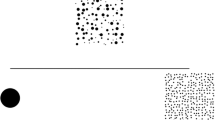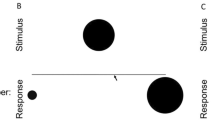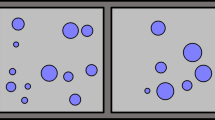Abstract
In the number-to-position methodology, a number is presented on each trial and the observer places it on a straight line in a position that corresponds to its felt subjective magnitude. In the novel modification introduced in this study, the two-numbers-to-two-positions method, a pair of numbers rather than a single number is presented on each trial and the observer places them in appropriate positions on the same line. Responses in this method indicate not only the subjective magnitude of each single number but, simultaneously, provide a direct estimation of their subjective numerical distance. The results of four experiments provide strong evidence for a linear representation of numbers and, commensurately, for the linear representation of numerical distances. We attribute earlier results that indicate a logarithmic representation to the ordered nature of numbers and to the task used and not to a truly non-linear underlying representation.












Similar content being viewed by others
Notes
In order to control for confounds, an inclusive ANOVA was performed, including gender (male, female) and hand (left, right) as between-subjects variables, in addition to the main reported variables. For both number and distance estimation, the ANOVA did not yield main effects or interactions for gender and hand (p > 0.05). A similar analysis with respect to RT did not yield effects.
We did not record any systematic differences between our German and Israeli participants.
References
Algom, D. (1992). Memory psychophysics: An examination of its perceptual and cognitive prospects. In D. Algom (Ed.), Psychophysical approaches to cognition (pp. 441–513). Amsterdam: Elsevier.
Algom, D., & Marks, L. E. (1990). Range and regression, loudness scales, and loudness processing: Toward a context-bound psychophysics. Journal of Experimental Psychology Human Perception and Performance, 16(4), 706–727.
Anderson, N. H. (1981). Foundations of information integration theory. New York: Academic Press.
Anderson, N. H. (1982). Methods of information integration theory. New York: Academic Press..
Ashby, F. G., & Maddox, W. T. (1994). A response time theory of separability and integrality in speeded classification. Journal of Mathematical Psychology, 38(4), 423–466..
Barth, H. C., & Paladino, A. M. (2011). The development of numerical estimation: Evidence against a representational shift. Developmental Science, 14(1), 125–135.
Ben-Nathan, M., & Algom, D. (2007). The perceived magnitude of two-digit numbers: A functional measurement analysis. Teori and Modelli, 12, 87–96.
Booth, J. L., & Siegler, R. S. (2008). Numerical magnitude representations influence arithmetic learning. Child Development, 79(4), 1016–1031.
Brannon, E. M., Wusthoff, C. J., Gallistel, C. R., & Gibbon, J. (2001). Numerical subtraction in the pigeon: Evidence for a linear subjective number scale. Psychological Science, 12(3), 238–243..
Cohen, D. (2009). Integers do not automatically activate their magnitude representation. Psychonomic Bulletin and Review, 16, 332–336.
Dehaene, S. (1997). The number sense. New York: Oxford University Press.
Dehaene, S. (2001). Précis of the number sense. Mind and Language, 16(1), 16–36..
Dehaene, S. (2003). The neural basis of the Weber–Fechner law: A logarithmic mental number line. Trends in Cognitive Sciences, 7(4), 145–147..
Fischer, M. H., & Adam, J. J. (2001). Distractor effects in pointing: The role of spatial layout. Experimental Brain Research, 136(4), 507–513.
Fischer, M. H., & Campens, H. (2009). Pointing to numbers and grasping magnitudes. Experimental Brain Research, 192(1), 149–153.
Fitousi, D. (2010). Dissociating between cardinal and ordinal and between the value and size magnitudes of coins. Psychonomic Bulletin and Review, 17(6), 889–894..
Fitousi, D., & Algom, D. (2018). A system factorial technology analysis is of the size-congruity effect: Implications for numerical cognition. Journal of Mathematical Psychology, 84, 57–73.
Gallistel, C. R., Gelman, R., & Cordes, S. (2006). The cultural and evolutionary history of the real numbers. In Levinson, S. & Jaisson, P (Ed.). Evolution and culture: A Fyssen Foundation symposium (17, pp. 247–274). Cambridge: MIT Press.
Garner, W. R. (1952). An equal discriminability scale for loudness judgments. Journal of Experimental Psychology, 43, 232–238.
Gescheider, G. A. (1997). Psychophysics: The fundamentals. Mahwah: Erlbaum.
Gilboa, I. (2009). Theory of decision under uncertainty. Cambridge: Cambridge University Press..
Goldfarb, L., Henik, A., Rubinsten, O., Bloch-David, Y., & Gertner, L. (2011). The numerical distance effect is task dependent. Memory and Cognition, 39, 1508–1517.
Guilford, J. P. (1954). Psychometric methods.. New York: McGraw-Hill.
Helson, H. (1964). Adaptation-level theory.. Oxford: Harper & Row.
Henik, A., & Tzelgov, J. (1982). Is three greater than five: The relation between physical and semantic size in comparison tasks. Memory and Cognition, 10(4), 389–395..
Izard, V., & Dehaene, S. (2008). Calibrating the mental number line. Cognition, 106(3), 1221–1247..
Kaufmann, L., Koppelstaetter, F., Delazer, M., Siedentopf, C., Rhomberg, P., Golaszewski, S., & Ischebeck, A. (2005). Neural correlates of distance and congruity effects in a numerical Stroop task: An event-related fMRI study. Neuroimage, 25(3), 888–898..
Krajcsi, A. (2017). Numerical distance and size effects dissociate in Indo-Arabic number comparison. Psychonomic Bulletin and Review, 24(3), 927–934.
Krajcsi, A., Lengyel, G., & Kojouharova, P. (2018). Symbolic number comparison is not processed by the analogue number system: Different symbolic and nonsymbolic numerical distance and size effects. Frontiers in Psychology, 9, 124.
Krause, F., Bekkering, H., & Lindemann, O. (2013). A feeling for numbers: Shared metric for symbolic and tactile numerosities. Frontiers in psychology, 4(7), 1–8.
Krause, F., & Lindemann, O. (2014). Expyriment: A Python library for cognitive and neuroscientific experiments. Behavior Research Methods, 46(2), 416–428.
Le Corre, M., & Carey, S. (2007). One, two, three, four, nothing more: An investigation of the conceptual sources of the verbal counting principles. Cognition, 105, 395–438.
Leth-Steensen, C., & Marley, A. A. J. (2000). A model of response time effects in symbolic comparison. Psychological Review, 107(1), 62–100.
Link, T., Nuerk, H.-G., & Moeller, K. (2014). On the relation between the mental number line and arithmetic competencies. The Quarterly Journal of Experimental Psychology, 67, 1597–1613.
Marks, L. E. (1974). Sensory processes: The new psychophysics. New York: Academic Press.
Marks, L. E., & Algom, D. (1998). Psychophysical scaling. In H. M. Birnbaum (Ed.), Measurement, judgment, and decision making (pp. 81–178). New York: Academic Press.
Moyer, R. S. (1973). Comparing objects in memory: Evidence suggesting an internal psychophysics. Perception and Psychophysics, 13(2), 180–184..
Moyer, R. S., & Landauer, T. K. (1967). Time required for judgements of numerical inequality.. Nature, 215, 1519–1520.
Namdar, G., Ganel, T., & Algom, D. (2018). The size congruity effect vanishes in grasping: Implications for the processing of numerical information. Scientific Reports, 8, 2723.
Norwich, K. H. (1992). Information, sensation, and perception. New York: Academic Press.
Núñez, R. E. (2017). Is there really an evolved capacity for number? Trends in Cognitive Sciences, 21(6), 409–424.
Pansky, A., & Algom, D. (2002). Comparative judgment of numerosity and numerical magnitude: Attention preempts automaticity. Journal of Experimental Psychology Learning Memory and Cognition, 28(2), 259.
Parducci, A. (1965). Category judgment: A range-frequency model. Psychological Review, 72(6), 407–418.
Pinel, P., Piazza, M., Le Bihan, D., & Dehaene, S. (2004). Distributed and overlapping cerebral representations of number, size, and luminance during comparative judgments. Neuron, 41(6), 983–993.
Pinheiro-Chagas, P., Dotan, D., Piazza, M., & Dehaene, S. (2017). Finger tracking reveals the covert stages of mental arithmetic. Open Mind, 1(1), 30–41.
Restle, F., & Greeno, J. G. (1970). Introduction to mathematical psychology. Oxford: Addison-Wesley.
Reynvoet, B., & Sasanguie, D. (2016). The symbol grounding problem revisited: A thorough evaluation of the ANS mapping account and the proposal of an alternative account based on symbol–symbol associations. Frontiers in Psychology, 7, 1581
Rips, L. J. (2013). How many is a zillion? Sources of number distortion. Journal of Experimental Psychology Learning Memory and Cognition, 39(4), 1257–1264.
Rouder, J. N., & Geary, D. C. (2014). Children’s cognitive representation of the mathematical number line. Developmental Science, 17(4), 525–536.
Sasanguie, D., et al. (2014). The approximate number system is not predictive for symbolic number processing in kindergarteners. Quarterly Journal of Experimental Psychology, 67(2), 271–280.
Sasanguie, D., De Smedt, B., & Reynvoet, B. (2017). Evidence for distinct magnitude systems for symbolic and non-symbolic number. Psychological Research Psychologische Forschung, 81(1), 231–242.
Siegler, R. S., & Opfer, J. E. (2003). The development of numerical estimation evidence for multiple representations of numerical quantity. Psychological Science, 14(3), 237–250.
Siegler, R. S., Thompson, C. A., & Opfer, J. E. (2009). The logarithmic-to-linear shift: One learning sequence, many tasks, many time scales. Mind Brain and Education, 3(3), 143–150.
Slusser, E., & Barth, H. (2017). Intuitive proportion judgment in number-line estimation: Converging evidence from multiple tasks. Journal of Experimental Child Psychology, 162, 181–198.
Slusser, E. B., Santiago, R. T., & Barth, H. C. (2013). Developmental change in numerical estimation. Journal of Experimental Psychology General, 142(1), 193–208.
Stevens, J. C. (1971). Psychophysics. In W. S. Cain & L. E. Marks (Eds.), Stimulus and sensation: Readings is sensory psychology. Boston: Little, Brown & Company.
Stevens, S. S. (1975). Psychophysics. New York: Wiley.
Van’t Noordende, J. E., Van Hoogmoed, A. H., Schot, W. D., & Kroesbergen, E. H. (2016). Number line estimation strategies in children with mathematical learning difficulties measured by eye tracking. Psychological Research Psychologische Forschung, 80(3), 368–378.
Verguts, T., Fias, W., & Stevens, M. (2005). A model of exact small-number representation. Psychonomic Bulletin and Review, 12(1), 66–80..
Verguts, T., & Van Opstal, F. (2005). Dissociation of the distance and size effects in one-digit numbers. Psychonomic Bulletin and Review, 12(5), 925–930.
Verguts, T., & Van Opstal, F. (2014). A delta-rule model of numerical and non-numerical order processing. Journal of Experimental Psychology Human Perception and Performance, 40(3), 1092–1102.
Acknowledgements
We thank James Townsend, Attila Krajcsi, and an anonymous referee for helpful comments on earlier versions.
Funding
No funding was received for this study.
Author information
Authors and Affiliations
Corresponding author
Ethics declarations
Conflict of interest
All authors declare that they do not have a conflict of interest.
Ethical standards
All procedures performed in studies involving human participants were in accordance with the ethical standards of the institutional and/or national research committee and with the 1964 Helsinki declaration and its later amendments or comparable ethical standards.
Research involving human and animal participants
This article does not contain any studies with animals performed by any of the authors.
Informed consent
Informed consent was obtained from all individual participants included in the study.
Electronic supplementary material
Below is the link to the electronic supplementary material.
Rights and permissions
About this article
Cite this article
Bar, H., Fischer, M.H. & Algom, D. On the linear representation of numbers: evidence from a new two-numbers-to-two positions task. Psychological Research 83, 48–63 (2019). https://doi.org/10.1007/s00426-018-1063-y
Received:
Accepted:
Published:
Issue Date:
DOI: https://doi.org/10.1007/s00426-018-1063-y




